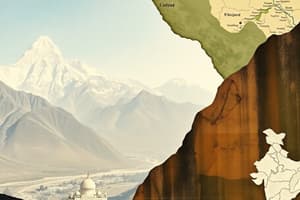Podcast
Questions and Answers
Where does the Indus River originate?
Where does the Indus River originate?
- Tibetan Plateau (correct)
- Kailash Range
- Arabian Sea
- Himalayas
Which rivers join the Indus to form the Indus Basin?
Which rivers join the Indus to form the Indus Basin?
- Nile, Amazon, Yangtze
- Zambezi, Ganges, Mekong
- Danube, Rhine, Volga
- Zanskar, Shyok, Gilgit (correct)
What is the average flow rate of the Indus River?
What is the average flow rate of the Indus River?
- 350 cubic meters per second
- 209 cubic meters per second (correct)
- 50 cubic meters per second
- 120 cubic meters per second
What has the construction of large dams along the Indus River led to?
What has the construction of large dams along the Indus River led to?
What role do the Tarbela Dam, Mangla Dam, and Wullar Barrage play in the region's development?
What role do the Tarbela Dam, Mangla Dam, and Wullar Barrage play in the region's development?
Which endangered species is mentioned as inhabiting the Indus River Basin?
Which endangered species is mentioned as inhabiting the Indus River Basin?
What are some challenges faced by the Indus River mentioned in the text?
What are some challenges faced by the Indus River mentioned in the text?
What impact can alterations to the natural flow of the Indus River have?
What impact can alterations to the natural flow of the Indus River have?
How is the Indus River described in terms of its cultural significance?
How is the Indus River described in terms of its cultural significance?
What makes the Indus River an important subject for study and exploration?
What makes the Indus River an important subject for study and exploration?
Study Notes
Diving into the Indian Rivers: The Himalayan Giant, the Indus
The Indus River, the lifeblood of a region that spans modern-day Pakistan, India, and China, is one of the most iconic waterways of the Indian subcontinent. Flowing from the Tibetan Plateau, the Indus is part of the Himalayan river system, a network of rivers that originates in the Himalayas and helps sustain a vast region.
Origins and Course
The Indus River begins its journey on the Tibetan Plateau, flowing from the glaciers of the Kailash Range. This mighty river, joined by the Zanskar, Shyok, and Gilgit rivers, forms the Indus Basin, the largest drainage basin in Asia. The Indus then flows eastward, passing through the disputed region of Kashmir, before pivoting westward, finally reaching the Arabian Sea in Pakistan after a nearly 2,900-kilometer journey.
Features and Characteristics
The Indus River is a perennial river, flowing steadily throughout the year, except for the lower reaches that experience seasonal flooding. The river's width varies along its course, ranging from a narrow 200 meters near the Indian border to an expansive 3.5 kilometers at its delta in Pakistan. The Indus's average flow rate is approximately 209 cubic meters per second, making it the 17th largest river by discharge volume in the world.
Dams and Irrigation
The construction of several large dams along the Indus River has led to extensive irrigation and hydroelectric power generation in the region. Notable dams include the Tarbela Dam, the Mangla Dam, and the Wullar Barrage, which provide water for irrigation and electricity generation, playing a pivotal role in the socio-economic development of the region.
Ecological Aspects
The Indus River Basin is home to an incredibly diverse range of flora and fauna, many of which are endemic to the region. The river's ecosystem supports numerous species of fish, birds, and mammals, including the endangered Ganges river dolphin and the critically endangered Siberian crane. The river also serves as a critical water source for millions of people living in the region.
Challenges
Like many of the world's rivers, the Indus faces several challenges, including pollution, water scarcity, and habitat destruction. Water pollution is particularly severe, with industrial and agricultural waste contributing to the decline in water quality. Additionally, alterations to the natural flow of the river, such as the construction of dams, can lead to the disruption of migratory patterns and alter the river's ecosystem.
Cultural Significance
The Indus River has been a source of inspiration and vitality for the various civilizations that have thrived along its banks, including the ancient Indus Valley Civilization. The river's rich history and cultural significance make it an important part of the region's heritage and identity.
In conclusion, the Indus River is a critical component of the Himalayan river system, and it plays a pivotal role in the socio-economic and environmental well-being of the region. Its diverse ecosystem and rich history make it an important part of the Indian subcontinent's heritage and a fascinating subject for study and exploration.
Studying That Suits You
Use AI to generate personalized quizzes and flashcards to suit your learning preferences.
Description
Delve into the origins, features, dams, ecological aspects, challenges, and cultural significance of the Indus River, a vital waterway in the Indian subcontinent. Learn about its course, diverse ecosystem, and the socio-economic impact of dams along its path.




